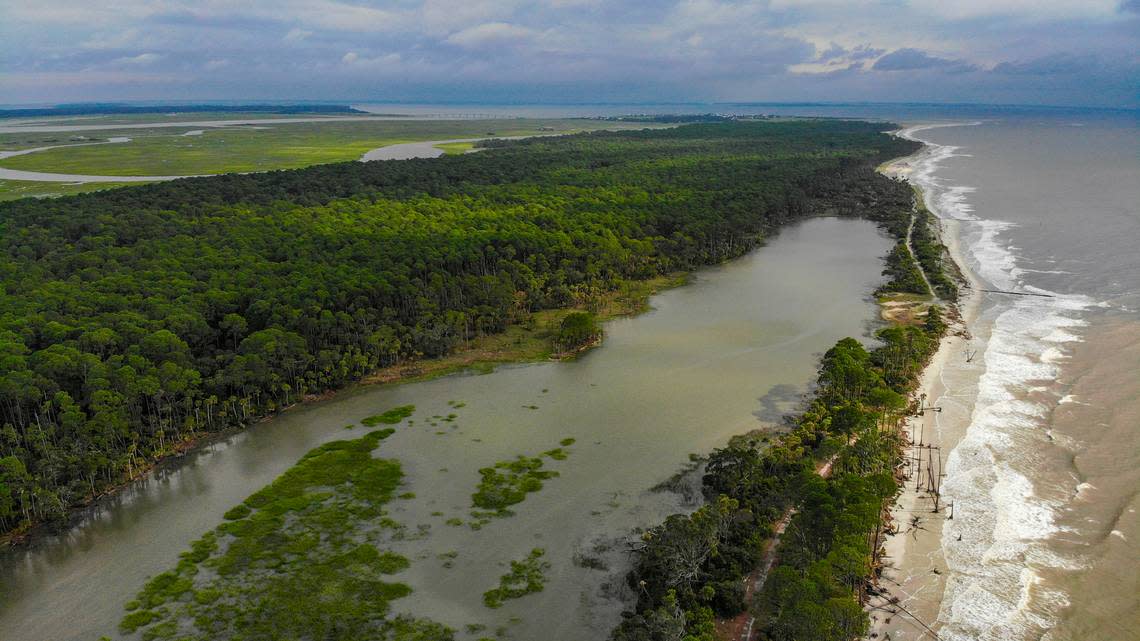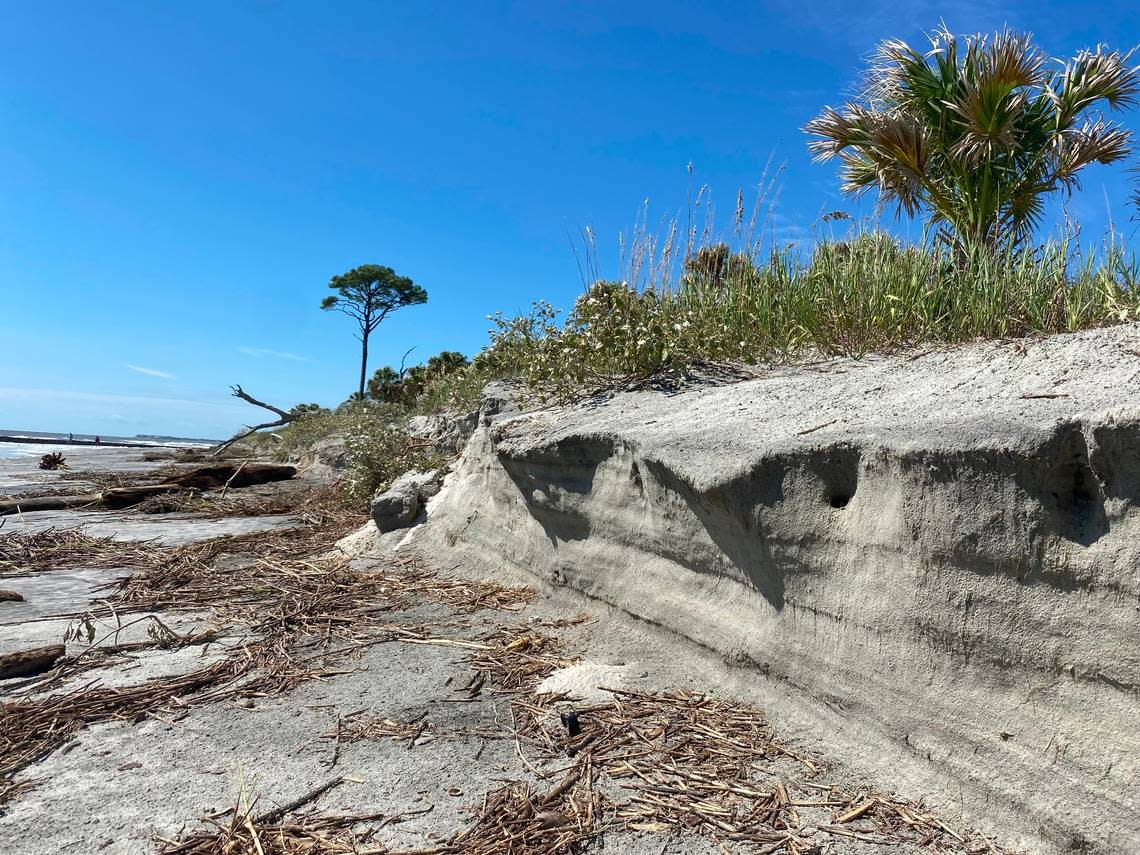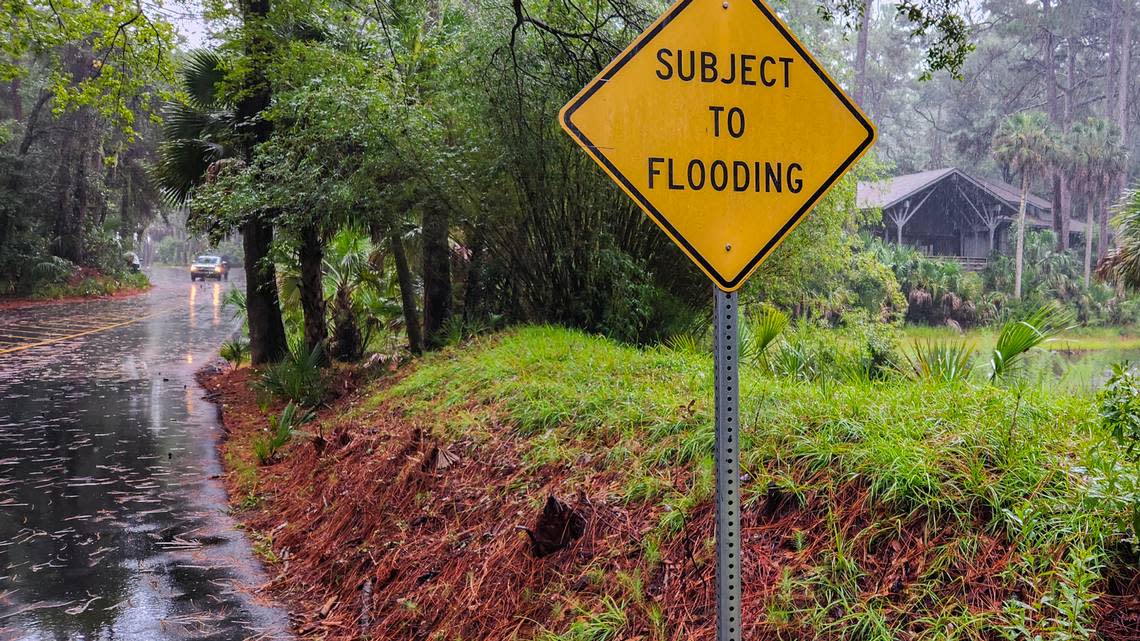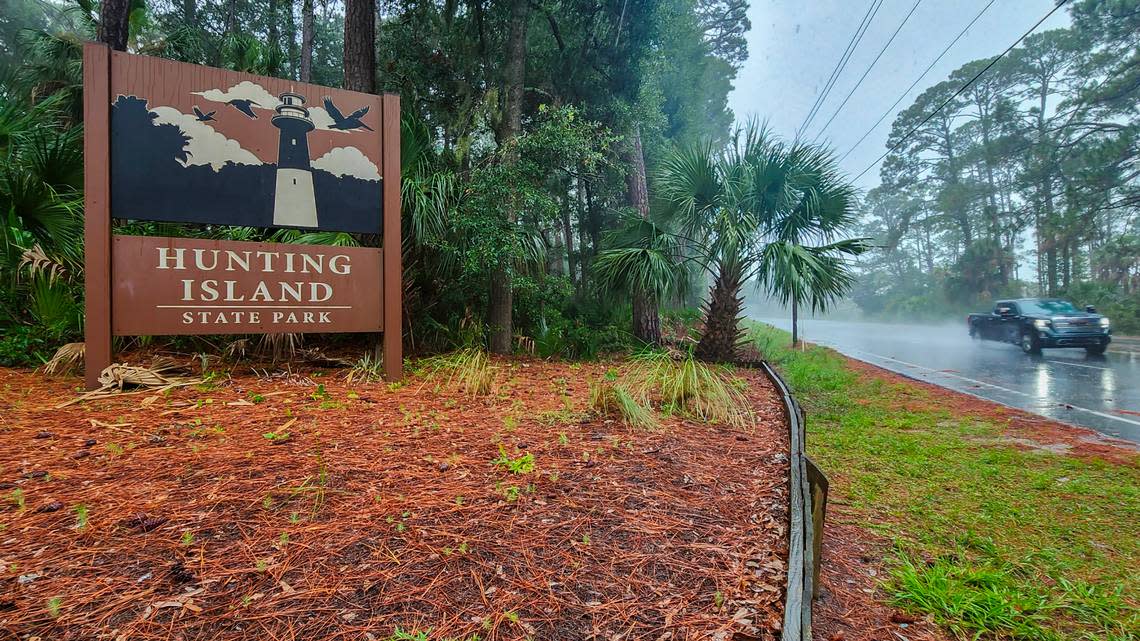Hunting Island is a South Carolina treasure. Does preserving it come at a cost too high?
Nearly four decades ago, a young Jessica Plavic couldn’t begin to measure the length of Hunting Island’s south end shoreline. It was too vast in her eyes.
Through an 11-year-old’s lens, it felt like she could walk out “miles and miles” into the ocean. That was when she and her family first stayed at one of the dozens of cabins that used to dot the South Carolina barrier island’s lower quarter.
Each year since, Plavic has returned to the beach she unequivocally calls her “favorite place in the whole world.”
But the beach she loves is disappearing, and it may not be a natural process. South Carolina’s effort to slow erosion on other parts of Hunting Island’s beach — including the area near its signature lighthouse — has taken a toll on the south end, scientists say.
In over a decade, erosion has accelerated on the south end as sand-trapping devices called groins have been installed, they attest.
The groins, which run into the ocean perpendicular to the beach, hold sand in place for the middle and upper parts of Hunting Island so that vacationers and locals alike will have a wide beach.
Unfortunately, they are working to leave the south end in even worse shape, said Rob Young, a coastal erosion expert at Western Carolina University.
The south end of Hunting Island, which is about 2 miles below the over-a-century-old lighthouse and about 1 mile north of Fripp Island, is an important part of the state park. A popular, recently built fishing pier is there, a large lagoon where parts of the movie Forrest Gump were filmed and there’s breathtaking, unfettered nature that draws in the curious.

Steven Traynum, and the team at Coastal Science and Engineering, which specializes in solving problems in the coastal zone, worked with the state parks staff on the recent renourishment and groin projects designed to protect Hunting Island’s shoreline. Traynum contends that the groins have not sped up erosion on the south end, rather the rate of erosion was natural for the barrier island.
“Away from the groin clusters, the shoreline was expected to continue eroding and retain its characteristic ‘boneyard’ beach of dead trees in the surf,” a report by the group said of its earlier 2006-2007 renourishment and groin projects.
More recently, Traynum said that through its surveys, the engineering company was “able to show pretty conclusively that the groins haven’t had an impact” on erosion rates of the south end.
But Young isn’t convinced.
The sheet-pile and rock groins have morphed Hunting’s shoreline from a straight line, which a barrier island should naturally look like, into more of a boomerang shape, with both ends tapering off, essentially inconsistently eroding.
“The rate at which the southern end of the island has eroded is just really staggering,” Young said.
Preserving Hunting Island comes at what cost?
Over five decades, state and federal officials have funneled tens of millions in state and federal funds to save the island’s center beach from severe erosion.
Over time, eight groins, intended to keep the sand in place and slow down erosion, were built into the beach. Installing the two most-recent sheet-pile groins, in 2019, cost over $1.3 million.
Sand has also been pumped onto Hunting Island nine times in response to erosion and storms in that time. The projects have cost taxpayers nearly $30 million.
These are attempts to preserve Hunting Island State Park, the only public-access beach in northern Beaufort County. It’s a place people call magical, a state treasure, an asset that brings in about 1 million visitors each year, and an economic-driver that raked in $4.7 million in 2022.
Throughout the years, Plavic has watched erosion eat away at Hunting Island’s shoreline.
She remembers when Hurricane Matthew pummeled the barrier island in 2016 so badly that it forced a breach at the south end — permanently splitting it into two sections. Since then, the lower half, disconnected from the rest of the island, was nicknamed “Little Hunting.”
Plavic’s seen erosion expose live oaks’ root systems — the roots are so high now that this summer, when her son, who’s almost 6 feet tall, stood on the beach next to exposed roots of a live oak, he was dwarfed by the spindly roots’ height. Wiry root systems, felled trees and remnants of once-standing cabins earned the section its own moniker: the boneyard.
Shortly after Matthew struck, the two remaining cabins were removed. All the while, the middle section of the island was spared by man-made attempts to keep sand in place.
At one point, Hunting island was once deemed the fastest-eroding island in South Carolina, losing between 20 to 25 feet of beach a year on the south end. Because of this, Traynum and Tim Kana, also at Coastal Science and Engineering, decided groins were the best chance to stymie the island’s rapid erosion.
For a beach losing about 2 feet a year, renourishment projects are enough to maintain an eroding shoreline, said Traynum, a marine scientist and project manager with the group. But Hunting Island, where parts of the beach were losing more than 10 times that, required more than additional sand for shoreline stabilization.

“The idea with the groins is that you’re not stopping erosion from occurring, but you’re slowing it down to something much more manageable,” he said. “You’re not having to do projects every three or four years, you can do projects every 10 or 12 years.”
When the latest groin projects were pitched by the group, environmentalists pushed back.
The South Carolina Coastal Conservation League, examining the existing groins before the 2019 renourishment and groin installment projects, said while “the beach’s updrift of the groins are generally healthy, the downdrift beaches experience accelerated erosion,” meaning the section of beach above the groins was fine but the area below eroded faster than what was natural. The erosion in the boneyard area was exacerbated by the groins placement, many environmentalists and scientists say, because the sand was trapped between the groins, which didn’t allow it to naturally flow down to the south end.
In 2018, the state parks reached a settlement with conservation groups, which included knocking the proposed four groins down to one with an option to build a second.
While Young contends groins have worsened south end erosion, he said other factors have contributed, including storms and natural movement of barrier islands.
Barrier islands are re-exposed sandbars that lay parallel to the main shoreline and serve to protect it from hurricane and storm destruction. Built up sand dunes and beaches are a defense system, and the shore-facing side protects what are often marshes or maritime forests behind it. When waves and wind beat against the front end of the barrier island, they pull sand away and carry it into the ocean, depositing slightly south of where it was before. It’s a process called longshore transport. Essentially, the front ends are being eroded and the back ends are being built on.
But when humans manipulate a barrier island, it can obstruct the natural process of longshore transport, which can speed up erosion on other parts of the beach, scientists say.
Hurricanes and other hazardous storms also whittle away shorelines. With scientists predicting sea levels will rise and storms will surge harder and more often than ever before, there could be an increase in natural erosion rates. It’s a reality that will continue to eat away at Hunting Island’s shoreline.
“Seeing the (south) beach the way that it used to be versus how it is now with all the dead and decaying trees … that’s one of the most heartbreaking things,” Plavic said.
Hunting Island’s other problem
Hunting Island State Park has another battle with Mother Nature, one that’s problematic for visitors even before reaching the shoreline.
“What I think will be the biggest challenge for Hunting Island in the future is not the shoreline movement on the oceanfront, but the fact that it’s so low, that rising sea level has brought the water table underneath that entire barrier island,” Young said.
The roads on the inland part of Hunting are nearly at sea level, he explained, which can be seen when looking at how close the road is to the upper levels of the spartina marsh. When it rains, it’s difficult to get rid of the sitting water from the sides of the road and campground. Trees that would normally soak up the excess water are dying because of the lifting water table.
With groundwater rising as sea levels increase, the excess water has to go somewhere and if it can’t run off, it ponds. Young said he’s already seen this at Hunting Island, and has watched as workers pump out water because the park can’t naturally get rid of it after a heavy rainstorm.

In the next 10 to 20 years, Young said the park’s biggest concerns should be rising sea levels, internal flooding and the dying trees that normally soak up excess water. The sitting water in the inland part of Hunting Island could become so problematic that it could cut off access to the reach the beach.
Thomas “Zabo” McCants, Hunting Island State Park/St. Phillips Island manager, said alongside pumping out standing water, the park service has reopened a swash between the campground and north beach area.
The swash is a natural breach that drains the excess water from the island, down along the beach and into the ocean.
“We have to evolve as the island evolves,” McCants said. “We have to be open-minded that unfortunately we aren’t in control of nature, but we are in control of how we respond to what nature does to the island, and how we look to manage and change with its evolution.”
Hunting Island’s future
How best to address Hunting Island’s erosion and flooding issues doesn’t have a straightforward answer. And they are issues that have plagued the beloved park for years.
“We’ve been trying to preserve it my entire lifetime. Probably longer than that,” said Arthur Levin, a longtime Beaufort County resident. “I don’t know that we can beat Mother Nature.”
The state favors renourishment projects to combat erosion and deals with flooding when it arises. Traynum thinks an additional groin is needed on the beach. And environmentalists are looking at the long-term — how do you get to an island that’s predicted to have its internal roads flooded over?
McCants, who earned his post about four months ago, said he’s still learning how best to manage the park in the short- and long-term.
Each day, McCants and park staff handle day-to-day needs of Hunting Island, like the recent clean-up after Tropical Storm Idalia blew through. But the bigger planning process happens alongside the South Carolina Department of Parks, Recreation and Tourism. McCants said they’ve made cyclical plans for years to come. One of those included is renourishment.
The state recommends that beaches be renourished every seven to 10 years. But beach renourishment is neither a straightforward process nor a given.
There’s high demand for renourishment. Many beach communities are competing to renourish their beaches, said Jessie White, South Coast office director at the Coastal Conservation League. People are fighting for needed equipment, which is backlogged, and may settle for subpar sand.

But what are the plans to address flooding, environmentalists ask. When do renourishment projects become more expensive than they’re worth?
Environmentalists have ideas but first, they say they want a seat at the table. The Coastal Conservation League says it has not previously been successful when reaching out to the park service for collaboration on long-term management.
“We wanted to be able to have an open dialogue with the park service,” White said, adding that the league wants to work with the service to identify solutions knowing that climate change is only going to exacerbate erosion and flooding issues at the park.
Emily Cedzo, a senior program director at the Coastal Conservation League, threw out creative long-term options specifically to address flooding. Roads and parking sections could be elevated. Stormwater ponds could work to collect the rainwater and contain outfalls in order to drain them. Fleshing out these plans, even if the decision is to leave the island as be, could become the road map for how barrier islands are managed in South Carolina.
“(It’s the) ultimate question of, ‘What do you want Hunting Island to be?’” Cedzo posed. “Do you want it to be this beach where you can easily park your car and then walk out to the beach? Do you want it to be a special, natural, unique place to some extent? And if it’s the latter, I think the reality is we have to ask ourselves, are we using the right ideas if we just keep engineering and relying on hard infrastructure?”
But they’re plans for a future that Mother Nature will ultimately decide.
“We have to reconcile the fact that barrier islands are dynamic and fleeting in nature, and there may be things that we can do to slow things down.” White said. “You want to love something for what it truly is.”
